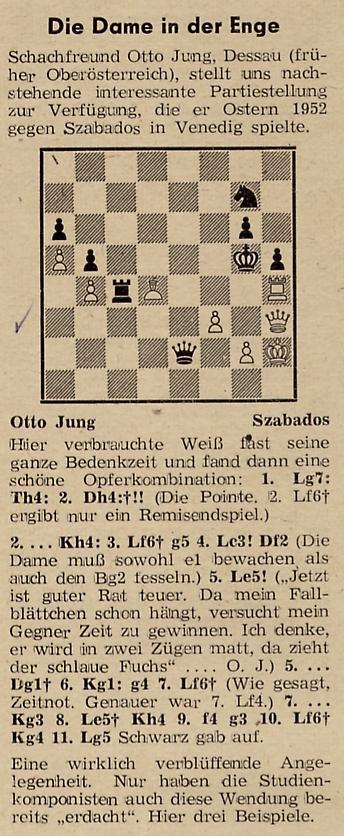
When contacting us by e-mail, correspondents are asked to include their name and full postal address and, when providing information, to quote exact book and magazine sources. The word ‘chess’ needs to appear in the subject-line or in the message itself.
| First column | << previous | Archives [26] | next >> | Current column |
Pages 77-78 of Chess Facts and Fables tried, unavailingly, to unravel contradictory information about a widely-published Zugzwang position from the 1950s. Who exactly were the players (usually identified as Jung and Szabados), and why was the venue variously given as Hungary, Venice and Dessau?
We are grateful now to Alan McGowan (Waterloo, Canada) for sending the following, from page 165 of the 11/1956 issue of Schach:

An outstanding point about this game (played in Venice in 1952, it is now known, although the full score has yet to be found) is whether Black was Eugenio or Paolo Szabados.
Neil McDonald (Gravesend, England) asks:
‘When did the word “fianchetto” first come into popular usage (as opposed to being coined)?’
Outside of Italy, at least, we wonder whether ‘fianchetto’ was widely understood by chessplayers until the second quarter of the nineteenth century, by which time games featuring the manoeuvre were by no means uncommon.
The first two volumes of the Chess Player’s Chronicle (1841 and 1842 – pages 49-51 and 182-183 respectively) had games which began 1 g3, although ‘fianchetto’ did not appear. However, the fianchetto was often regarded as an eccentricity, and on page 28 of The Art of Chess-Play: A New Treatise on the Game of Chess (London, 1846) George Walker wrote:
‘Some players always begin the game by moving their knights’ pawns one square, and then playing the bishops on to the knights’ second squares. Avoid this, as productive of a crowded situation.’
‘On the Fianchetto’ was a sub-heading in a section entitled ‘On Several Incorrect Openings’ on page 36 of Jaenisch’s Chess Preceptor by C.F. de Jaenisch and translated by Walker (London, 1847). After 1 e4 b6 the following comment was given:
‘It is, in general, dangerous to advance the knights’ pawns one before the close of the game; for the wings become necessarily weakened, and castling is thereby rendered dangerous. Moreover, two squares are opened to attack, which the bishops cannot always continue to defend by occupying the intervals, as surely as even the pawns themselves. The move 1...b6 is less to be condemned than 1...g6 because it is on queen’s flank; and because the bishop placed on b7 batters the adverse royal wing; while the move 1...g6 weakens the royal flank; and only yields KB an attacking range upon adverse queen’s side.’
Pages 379-380 of Staunton’s The Chess-Player’s Handbook (London, 1847) had a game headed ‘The Fianchetto’, with this note after 1 e4 b6:
‘Black’s present move, which the Italians call “Il Fianchetto di Donna”, although disapproved of by the earlier writers, may be made by the second player without harm, if followed speedily by ...e6 and ...c5. It is not, however, so advisable a mode of opening the game for the first player as the more customary moves, from its being essentially defensive.’
Around this time, ‘fianchetto’ was usually a reference to 1 e4 b6. For instance, on page 298 of the October 1858 Chess Monthly this definition was given:
‘Fianchetto, Sub. The title of an opening formed by 1 e4 b6. It is derived from the Italian Fianco, flank, and the diminutive termination etto.’
The section headed ‘The Fianchetto’ on page 266 of The Chess Openings by Robert B. Wormald (London, 1875) also concerned only 1 e4 b6. Later openings books gradually used ‘fianchetto’ more broadly, one example being Chess Openings Ancient and Modern by E. Freeborough and C.E. Ranken, various editions of which had ‘King’s Fianchetto’ for 1 g3 and ‘Queen’s Fianchetto’ for 1 b3, as well as ‘The Fianchetto Defence’ for 1 e4 b6 and 1 e4 g6. Some later volumes retained the Italian terms ‘Fianchetto di Donna’ and ‘Fianchetto di Re’; see, for example, page 3 of the fifth edition of The Chess Players’ Compendium by William Cook (Philadelphia, 1910).
The above are, of course, merely jottings on how usage of ‘fianchetto’ evolved in English-language sources, and we shall be grateful for further relevant citations.
On page 344 of the August 1927 BCM the following game annotation appeared after 1 e4 e6 2 g3: ‘“Everything gets fianchettised nowadays”, wrote Dr Tartakower a few years ago.’ Where did that observation first appear?
Justin Horton (Huesca, Spain) wonders who was being referred to by Gerald Abrahams in the following paragraph from page 115 of his book Not Only Chess (London, 1974):
‘The computer, however, has no judgement, except the arithmetical. They say of the computer that if it has to choose between two clocks, it prefers the one that has stopped to the one that loses a second a day, because the former is accurate twice a day and the other is only accurate after many days. In this the computer resembles an unlamented Times correspondent who reviewed the position at the adjournment in a Hastings Congress. On each of five boards he predicted victory for the player with the pawn to the good. In every case that player lost.’
The name of E.S. Tinsley naturally comes to mind (see pages 245 and 272 of Chess Explorations), but we know nothing about the specific accusation made by Abrahams.
Anthony Stebbings (London) writes regarding Chess Eccentricities by George Hope Verney (London, 1885):
‘The Dedication is to the Duchess of Albany. The Preface includes a passage from the speech by the Duke of Albany (“who was an inveterate chessplayer, and who also took a great interest in four-handed chess”) at the Birkbeck Institute, 1879. The passage includes sentences preceding those given in C.N. 4044:
“There is so much similarity in the conditions of all effort and all success that even the studies which seem most remote from active life may always furnish a moral which life can adopt and employ. For instance, I notice that in what is called the ‘Miscellaneous Department’ of your curriculum you provide instruction in the game of chess. This is not the most obviously practical of your subjects, but it has struck me that even those, if any there be, who desire to limit their education to this branch alone, may learn some not unimportant lessons of life from the manner in which you teach it. ‘Particular attention’, I see your programme says, ‘is paid to the study of the openings.’ Now, is it not true ...” (and the text continues as in C.N. 4044).’
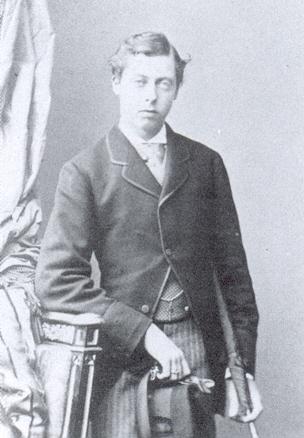
Prince Leopold
From page 73 of Koltanowski’s Chess Annual 1955 (San Francisco, 1955):
‘Backward pawn – An unsupported pawn which cannot be moved immediately into the protection of another pawn.’
‘Center – Generally refers to the king’s and queen’s files and to a lesser degree to the bishops’ files.’
‘En passant – (Fr., in passing) The capture of a pawn which has moved from its second to its fourth rank by an opposing pawn which stands on its own sixth rank.’
‘Hanging pawns – Two or more connected pawns unsupported by others.’
If these definitions are taken literally, as definitions are supposed to be, an intriguing assessment may be made of this imaginary position:
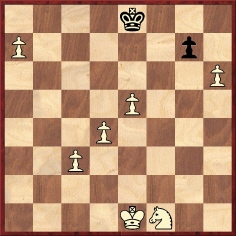
Black to move.
White, to follow Koltanowski, has backward pawns on a7 and h6, quite apart from his hanging pawns on c3, d4 and e5. His knight is in the centre. Black advances his own backward pawn (1...g5), and White captures it en passant with his h6-pawn.
Bradley J. Willis (Edmonton, Canada) draws attention to the Canadian politician William Aberhart (1878-1943), whose interest in chess was mentioned on page 47 of Bible Bill by David R. Elliott and Iris Miller (Edmonton, 1987):
‘He still had time for long discussions on odd subjects that interested him, and also spent many evenings playing chess, one of the few forms of real relaxation he genuinely enjoyed. Like everything else Aberhart touched, chess was something serious; he even wrote a manual on it. One of his favorite opponents was Abe Shnitka, a Jewish printer who printed some of Aberhart’s religious booklets. Aberhart enjoyed a fast game of chess, and usually won; but if his opponent was slow to make a move, he would lose interest; his mind would wander and he would make mistakes. His friends from Westbourne would drop in during these events, and many a pleasant hour was passed with the game and in lively discussion.’
Our correspondent also points out that Appendix F (pages 243-249) of Aberhart of Alberta by L.P.V. Johnson and Ola MacNutt (Edmonton, 1970) reproduced extracts from the ‘manual’ in question, Conversational Chess (subtitled: ‘How to talk your Opponent out of the Game’). The first page is given below:

Mr Willis has hunted out the complete text, from the Provincial Archives of Alberta.
The first game in Conversational Chess (C.N. 4560) was 1 d4 f5 2 Bg5 h6 3 Bf4 g5 4 Bg3 f4 5 e3 h5 6 Bd3 Rh6 7 Qxh5+ Rxh5 8 Bg6 mate. This is a famous skirmish between Teed and Delmar which appeared in a novel figurine notation on page 44 of the June 1897 American Chess Magazine:
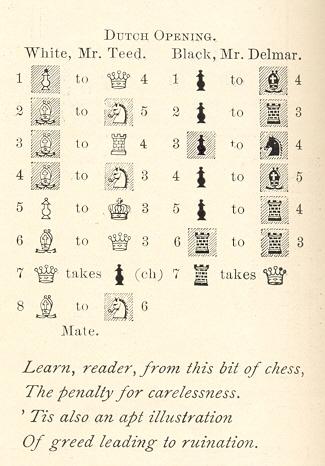
On page 244 of 200 Miniature Games of Chess (London, 1941) J. du Mont gave Teed’s victory and asserted:
‘The extreme beauty of this charming cameo loses a little of its glamour owing to the fact that the identical sequence of moves is found in one of Greco’s games (1622-1634).’
What grounds exist for that claim?
The earliest game beginning 1 d4 f5 2 Bg5 that we have found so far in a contemporary magazine is Carl Göring v Johann Berger, Graz, 1870 (Deutsche Schachzeitung, November 1870, pages 349-350). See also some later issues of the German magazine: October-November 1879, pages 298-300, May 1881, pages 153-155 and August-September 1881, page 288.
Information is sought on a game (1 d4 f5 2 Bg5 h6 3 Bh4 c5 4 e3 Qb6 5 b3 Nf6 6 dxc5 Qb4+ 7 White resigns) included in various databases and allegedly played between Hopton and Eastwood in 1860 [sic].
We conclude with a less familiar miniature, from page 411 of Brüderschaft, 10 December 1887:
P. Seufert – R.
Berlin, 2 December 1887
Dutch Defence
1 d4 f5 2 Bg5 g6 3 h4 Nh6 4 h5 Nf7 5 Qd2 h6 6 hxg6 Nxg5 7 Qxg5 hxg5 8 Rxh8 Resigns.
C.N. 4550 quoted Banks’ remark, ‘my best achievements at chess were probably my isolated victories over Marshall and Kashdan in one tournament’. That was in Chicago, 1926, and the event was won by Marshall ahead of Maróczy and Torre. Strange to say, it has not yet proved possible to find the game-score of Banks’ win over Marshall.
On pages 11-12 of Banks’ Blindfold Checker Masterpieces by N.W. Banks (Philadelphia, 1947) H. Helms wrote:
‘Marshall, as a rule, was a good loser. I can vividly recall his chagrin at losing this game. For a brief spell he was completely upset. They were nearing the end of the contest and the United States champion felt that this point might cost him the prize.
However, Fortune favored Marshall in the final round, in which all the “breaks” were in his favor and he came through half a point in advance of the field. It was in that round that Banks won brilliantly against Kashdan.’
Below is an inscription by Banks in one of our copies of the second edition of Banks’ Scientific Checkers (Detroit, 1929):
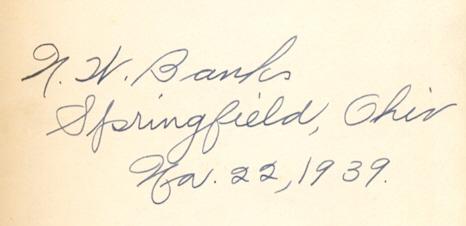
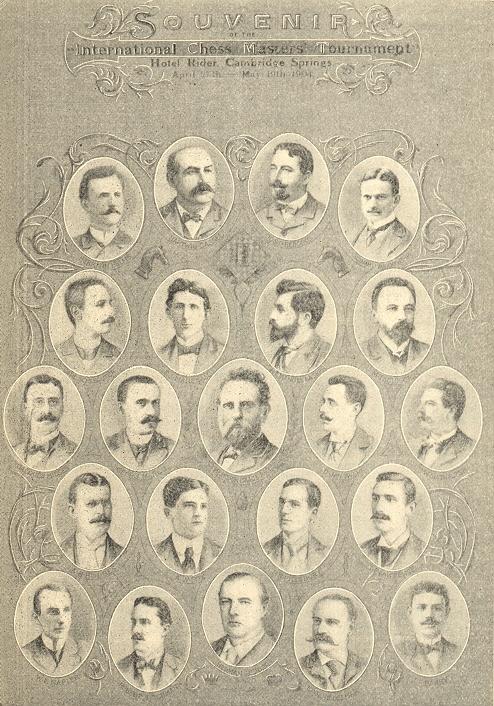

By far Capablanca’s rarest work is the 24-page introductory booklet Cartilla de Ajedrez, published in Havana in June 1913. (See page 46 of our book on Capablanca.) The contents were as follows:
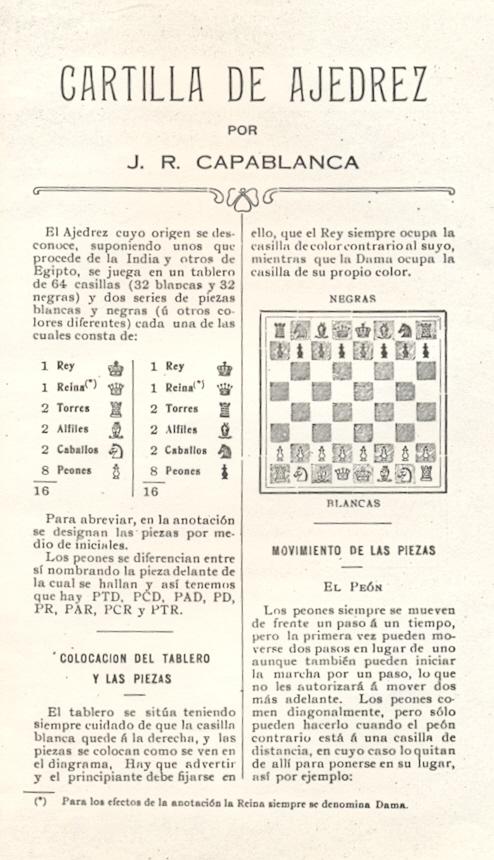
Who invented the term ‘Capablanca fright’? The earliest occurrence we recall at present is on page 178 of the December 1925 American Chess Bulletin, in a note by C.S. Howell about 12 Qe1 in the Cuban’s win over Bohatirchuk, Moscow, 1925:
‘“Capablanca fright?” White’s queen side now becomes a weak mess.’
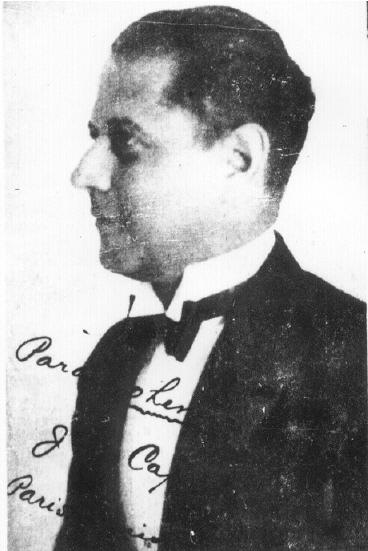
José Raúl Capablanca
It is surprising that Julius du Mont, who knew the Cuban quite well, made so many factual errors in his memoir in Capablanca’s Hundred Best Games of Chess by H. Golombek (London, 1947). A list compiled by us was made available in C.N. 3767, and here we revert to a puzzling case concerning Capablanca and Vidmar. As is well known, on page 17 du Mont wrote about Capablanca:
‘I remember his winning a brilliant game from Dr Vidmar in London, 1922, and laughingly patting the loser on the back, saying: “He always give [sic] me a chance of a brilliancy: he is my meat” – this accompanied by such a charming and good-natured smile that everyone, including Dr Vidmar, had the impression that he had bestowed the finest compliment on his opponent. Who else could make such a remark to his adversary and convey the feeling of the utmost friendliness?’
We quoted this on pages 317-318 of our book on Capablanca and commented:
‘The story cannot be correct, as before London, 1922 Capablanca and Vidmar had met only once, drawing in 20 moves.’
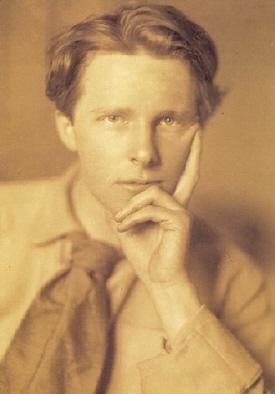
Rupert Brooke
As mentioned in C.N. 2372 (see pages 162-163 of A Chess Omnibus), various quotation books attribute the observation ‘History repeats itself; historians repeat one another’ to Philip Guedalla, in his 1920 work Supers and Supermen. In that item, though, we pointed out that the poet Rupert Brooke (1887-1915) gave the epigram as his own invention in a letter to Geoffrey Keynes dated 4 June 1906. See pages 53-54 of The Letters of Rupert Brooke chosen and edited by Geoffrey Keynes (London, 1968).
C.N. 2518 reported that the sole reference to chess that we had found in Brooke’s published writings was in his essay ‘An Unusual Young Man’. The scene is Munich:
‘Together, walking with ferocious care down the middle of the street, they had swayed through Schwabing seeking an open café. Café Benz was closed, but further up there was a little place still lighted, inhabited by one waiter, innumerable chairs and tables piled on each other for the night, and a row of chess-boards, in front of which sat a little bald, bearded man in dress-clothes, waiting. The little man seemed to them infinitely pathetic. Four against one, they played him at chess, and were beaten. They bowed, and passed into the night.’
Source: The New Statesman, 23 August 1914, pages 638-640. The essay also appeared on pages 215-222 of Brooke’s posthumous anthology Letters from America.
We recently learned that among the Brooke papers in the King’s College Archive Centre, Cambridge is a small (13 cm x 8 cm) notebook containing a few pages of chess material in the poet’s handwriting (reference RCB/M/21). The notes are in pencil and difficult to reproduce, but we are very grateful to King’s College for permission to show here two of the pages:
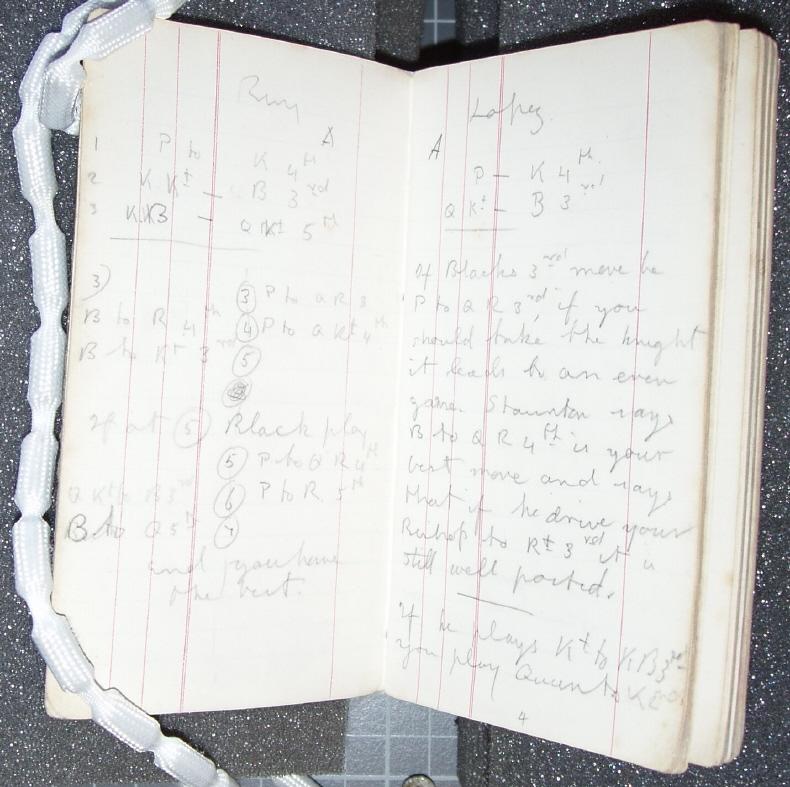
It seems to us that Brooke was copying openings material from a book or magazine which has yet to be identified. The reference to Staunton relates to remarks which had originally appeared on page 148 of his Handbook (London, 1847).
The other pages in the notebook have only brief jottings about chess openings. Elsewhere there are two (non-chess) entries dated 1902 and 1904, suggesting that the chess material was also written around that time, when Brooke was at Rugby School.
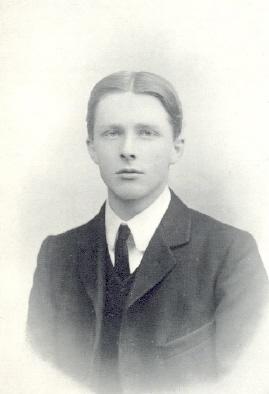
Rupert Brooke at Rugby School
C.N. 2865 (see page 75 of Chess Facts and Fables) asked for relevant information about the actress Marie Dressler (1869-1934), given that page 218 of Chess: Man vs Machine by Bradley Ewart (London, 1980) mentioned her ‘among the notables who were said to have played Ajeeb at the Eden Musée and were invariably defeated at chess or checkers’. Corroboration is still being sought, no progress having been made so far.
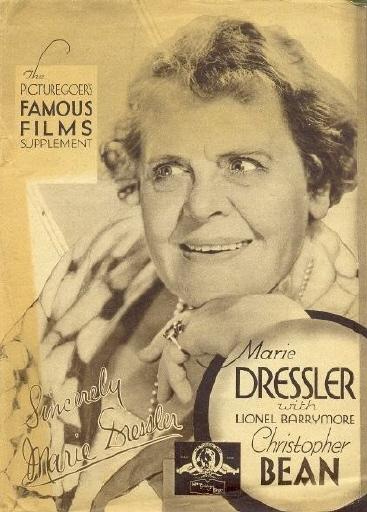
Front cover of a supplement to The Picturegoer, 1933
Also wanted: references to chess by or about the British writer Cyril Connolly (1903-74). We note, for instance, the following recollection of childhood on pages 151-152 of the 1983 edition of his book Enemies of Promise (originally published in 1938):
‘I collected stamps, pressed flowers in blotters and adored chess.’
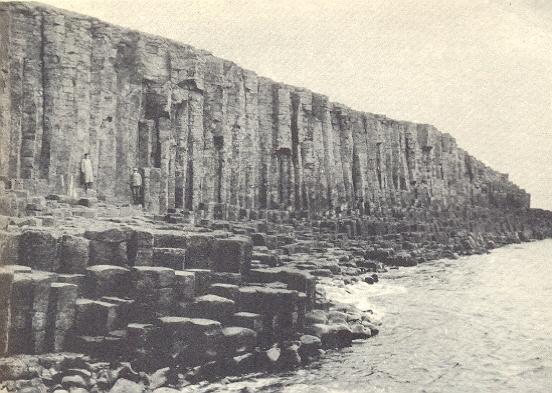
The above photograph, culled from page 41 of Within the Circle by Evelyn Stefansson (New York, 1945), is of the ‘rocky shore of Grímsey’. Below we reproduce page 38 of the book:

See also pages 68-69 of Chess in Iceland and in Icelandic Literature by Willard Fiske (Florence, 1905), page 178 of Willard Fiske Life and Correspondence by Horatio S. White (New York, 1925) and pages 54-55 of Willard Fiske in Iceland by P.M. Mitchell (Ithaca, 1989).
Bernd Graefrath (Mülheim an der Ruhr, Germany) writes:
‘In C.N. 3383 (included in the feature about large simultaneous displays on pages 300-304 of Chess Facts and Fables) you referred to a simultaneous exhibition by Hönlinger in Velbert in 1948. I have received from the Stadtarchiv in Velbert a copy of the report (entitled “Weltrekord gebrochen”) published in the local newspaper Rhein-Echo of 15 May 1948. Here is the complete text:
“Velbert. Als Auftakt zur Feier des 25jährigen Bestehens der Velberter Schachgesellschaft unternahm der frühere Wiener Meister Hönlinger einen erfolgreichen Angriff auf den Weltrekord im Simultanspiel. Hönlinger spielte zwölfeinhalb Stunden lang ununterbrochen gegen 213 der stärksten Spieler aus Westfalen und vom Niederrhein. Es gelang ihm, 187 Gegner matt zu setzen oder zur Aufgabe zu zwingen. Nur 13 Partien gingen für ihn verloren, während weitere 13 unentschieden endeten. Der bisherige Weltrekord wurde von dem Argentinier Najdorf – mit 184 Punkten aus 202 Partien - gehalten. Hönlinger erreichte 193½ Punkte. Um die internationale Anerkennung des in Velbert aufgestellten neuen Weltrekordes – von dem der Nordwestdeutsche Rundfunk aus dem ‘Rheinischen Hof’ in seinem ‘Westdeutschen Tagebuch’ berichtete – ist bereits nachgesucht.”
This report on Hönlinger’s display (+187 –13 =13) raises several questions. Had Najdorf previously played only 202 games, whereas other accounts mentioned in Chess Facts and Fables referred to 222 games by him? Did the world record concern the total number of games or (also) the number of points scored? Did Hönlinger play all 213 games simultaneously? And where could one apply (or, at least, appeal to) for official recognition of a world record?’
Readers’ assistance with these tricky matters will be appreciated. In the C.N. items on pages 300-304 of Chess Facts and Fables which discussed the conflicting reports on the large displays by Lilienthal, Ståhlberg, Najdorf and Hönlinger we found ourselves going around in circles, which makes the old adjective for such exhibitions (circumrotatory – see C.N. 4196) especially apposite. As regards ‘official recognition’, in any sport or game the world governing body may reasonably be expected to provide guidance and clarification, but how often has FIDE adopted a position on the validity of record claims? And from the FIDE of today can anything be expected?
Below is a photograph of Hönlinger during his display, from page 252 of the August 1948 CHESS:
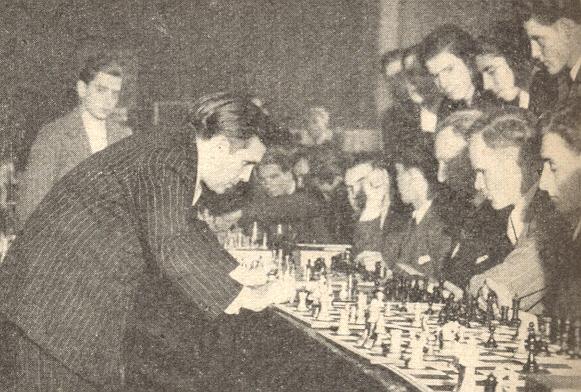
From Marek Soszynski (Birmingham, England):
‘Quite a few games played by Sammy Reshevsky in Switzerland are missing from everywhere I have looked:
Lugano, 1985:
Thesing v Reshevsky, Round 1. 0-1
Reshevsky v Franke, Round 2. 1-0
Pavlović v Reshevsky, Round 3. 1-0
Shamkovich v Reshevsky, Round 5. ½-½
Reshevsky v Nemet, Round 8. ½-½
Short v Reshevsky, Round 9. ½-½.Lugano, 1988:
Bosbach v Reshevsky, Round 2. ½-½
Benjamin v Reshevsky, Round 4. 1-0
Reshevsky v Gast, Round 5. ½-½
Axel Simon v Reshevsky, Round 6. ½-½
Huss v Reshevsky, Round 8. ½-½
Reshevsky v Ebelard, Round 9. ½-½.
Samuel Reshevsky at Lugano, 1988
One of these stands out, and I regard it as the Holy Grail of Reshevsky games: the draw against Nigel Short. Samuel Reshevsky by Stephen Gordon (Jefferson, 1997) did not give the moves but reported on page 348:
‘The bulletins printed a conversation overheard by John Nunn between Short and Reshevsky during their last round game:
Reshevsky: “Do you play for a win?”
Short: “Is this a draw offer?”
Reshevsky: “I can’t hear you.”
Short (louder): “Do you offer a draw?”
Reshevsky: “Is this a draw offer?”
Short: “No.”’
Below is an excerpt from a postcard which Reshevsky sent us on 3 February 1988:
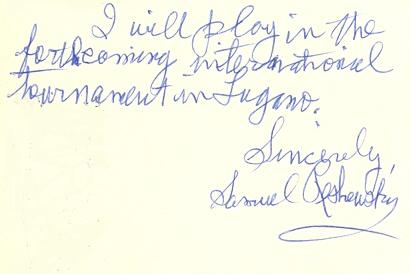
We wonder whether readers will recognize the chess book for beginners in which the following advice appeared:
‘Generally keep the L so that it may not be pinned by an M or an N, or be attacked when an O checks.’
Pages 354-355 of A Chess Omnibus discussed the identity of Colonel Moreau, who scored +0 –26 =0 at Monte Carlo, 1903. Little is yet known about him, but a few additional points can be made here.
As regards his forename, page 47 of the February 1903 Wiener Schachzeitung (edited by Marco, a participant in the tournament) had ‘Ch. [i.e. Charles] Moreau’.
It was mentioned in A Chess Omnibus that the list of subscribers to Reinfeld’s 1935 book on Cambridge Springs, 1904 included ‘C. Moreau’, and here we add that our copy of Reinfeld’s book Thirty-five Nimzowitsch Games, 1904-1927 (New York, 1935) contained, handwritten, the subscriber’s name, C.A. Moreau:
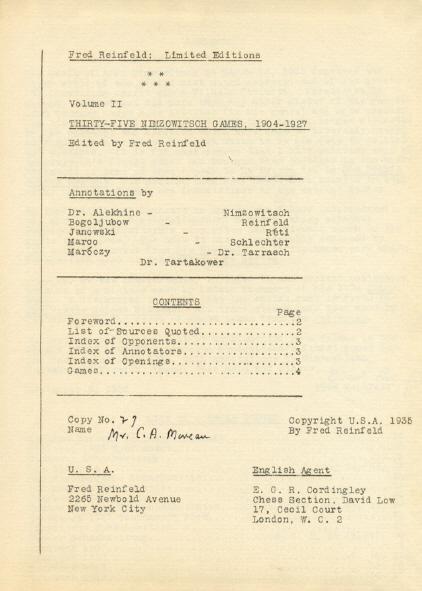
However, the list of subscribers on page 91 of Keres’ Best Games 1932-1936 (New York, 1937) by F. Reinfeld stated ‘C.L. Moreau’. Whether or not it was Colonel Moreau whom Reinfeld had among his subscribers is not known.
Page 51 of La Stratégie, 21 February 1903 stated that a Nice publication, Le Phare du Littoral, provided daily coverage of Monte Carlo, 1903 (results and games). Was any biographical information about Moreau included?
The 22 April 1903 issue of La Stratégie, page 113, announced Moreau’s recompense for his 26 defeats: 75 francs.
José Fernando Blanco (Madrid) has sent us an article on page 33 of the Corriere della Sera, 12 August 2006 by Matteo Collura about the publication of an unfinished novel, Shah Mat. L’ultima partita di Capablanca by Gesualdo Bufalino (1920-96):
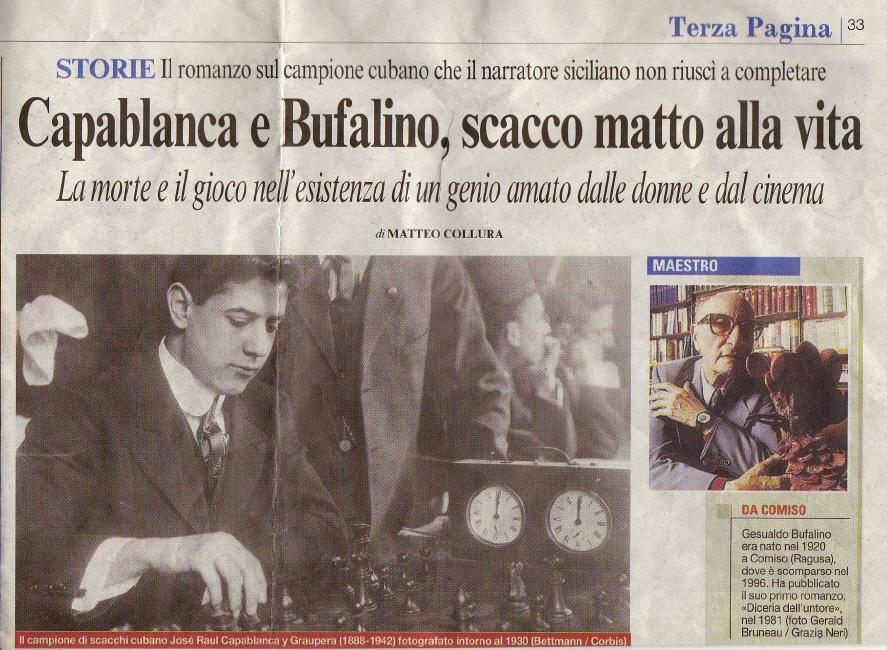
We have yet to see the book. On a matter of detail it will be noted that the fine photograph of Capablanca, from Bettmann/Corbis, is misdated ‘circa 1930’, whereas it was evidently taken towards the beginning of his career.
The previous item serves as a reminder of three unusual books in our collection with ‘Capablanca’ in the title:
The Capablanca Opening by David T. Chantler (New York, 1977). ‘A novel of intrigue.’
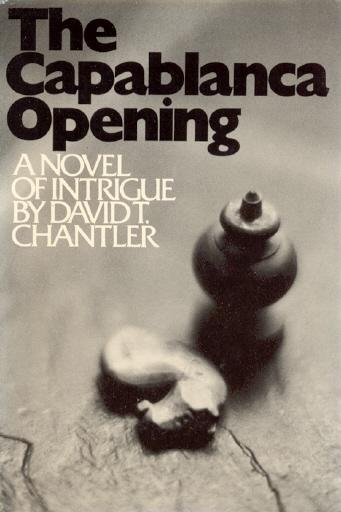
Ahora juega usted Señor Capablanca by Mario Zaldívar (San José, Costa Rica, 1994 and 2000). A novel starring Capablanca, set in the early 1930s.
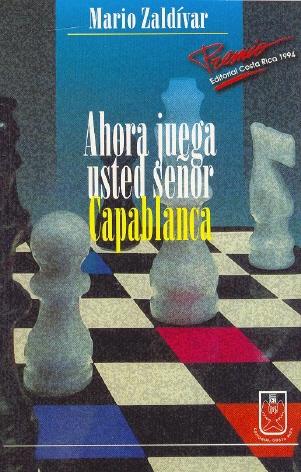
Capablanca’s real passion by Carlos Garaicoa (Prato, 2005). An illustrated account of the work of Garaicoa, a Cuban artist and architect. It is not about Capablanca, although there is a (misdated) photograph of him playing Marshall on page 177.
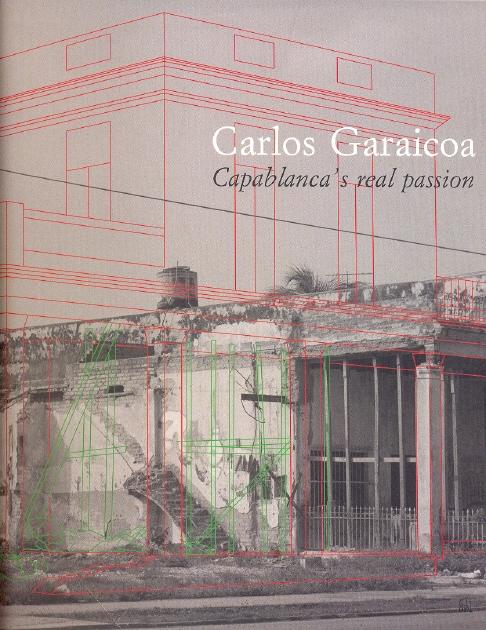
At a dinner organized by the Spanish Chess Federation at the Casino de Madrid in December 1935 Capablanca was questioned about his rivals. The Alekhine v Euwe world championship match was then being played in the Netherlands, and the Cuban was guarded on that subject. As for the future, he believed that he himself had the greatest right to challenge for the world title, followed by Flohr (who had enjoyed much success in recent years) and Lasker (regarded by Capablanca as still in the first rank of champions, despite his age). The Cuban had very high praise for Botvinnik, whom he considered more likely to become world champion than such other young players as Lilienthal and Reshevsky. Finally, Capablanca spoke highly of Tartakower, saying that he was, when on form, one of the most redoubtable masters.
The report, published on pages 491-492 of the December 1935 issue of El Ajedrez Español, is given below:
‘En estas contestaciones estuvo reservado respecto al resultado del match Alekhine-Euwe; nos reafirmó en nuestro convencimiento de que en orden de derechos la posición de los candidatos al título mundial son: Capablanca, Flohr (cuyos éxitos en estos últimos años son indiscutibles y de gran valor, según el maestro cubano) y Lasker, quien a pesar de su edad todavía está en primera fila de campeones, a juicio de quien le desposeyó del título mundial. De Botvinnik (el campeón ruso), hace Capablanca magníficos elogios y lo considera con más condiciones para llegar al título máximo que otros jóvenes que se han revelado en los últimos años, como Lilienthal y Reshevsky. También hace elogios de Tartakower, al que estando en forma considera uno de los más temibles grandes maestros.’
From page 3 of the Chess Player’s Chronicle, 10 June 1885:
‘Novel Chess Board. The South Australian Chronicle thus describes a board designed by Mr W. Braddock, and especially intended for beginners:
“The squares are marked out in the ordinary way, but instead of the dark colored ones being definitely red or black, each contains a complete diagram of the chess board, with the position of the men after the fifth move in some regular opening. Thus there are 32 of the principal openings represented. The designer has been very careful in omitting obsolete and notoriously unsound debuts, and he has done well in showing two or three variations in the more popular gambits, such as the Evans or the King’s. The board will be exceedingly useful as an aid to study.”’
A gap in chess records concerns the place of death of Ossip Bernstein. Jeremy Gaige’s Chess Personalia (1987 and 1994 editions) cautiously indicated only the country, France. In the first paragraph of his obituary on pages 72-74 of the March 1963 BCM Harry Golombek reported that Bernstein had died at a health resort (unnamed) in the French Pyrenees, while on pages 104-105 of the April 1963 Chess Review Edward Lasker wrote:
‘The last year of his life, Bernstein spent in St Arroman, a small quiet place in the Pyrenees, near his beloved Spain, to get away from the hustle and bustle of Paris which began to be too strenuous for him. He died in his sleep last 30 November, the day he was taken to a hospital for treatment of his weakening heart.’
What is required, of course, is information from a contemporary local source. Can a reader find out anything?
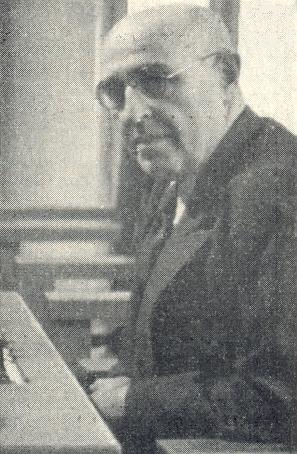
Ossip Bernstein
Which chess author also wrote medical guides and an anthology of poetry?
‘This week, in Chicago, a robot, controlled by a photo-electric cell, will take on all comers at chess. The presumptuous creation is even offering $150 to anyone who can outwit his moves engendered by the electric-eye principle. O ye spirits of the great and ye living masters. Evans and Steinitz, Euwe and Alekhine. Gang up mercilessly on this soulless monster, split the profits and, most of all, re-establish the dignity of the human mind.’
That call to arms appeared in the Chicago Daily News and was cited on page 109 of the September-October 1938 American Chess Bulletin. What more is known about the robot?
In a famous game played in Boston in 1899 J.F. Barry defeated H.N. Pillsbury. After 1 e4 e5 2 Nf3 Nc6 3 Bb5 Nf6 4 d4 Nxe4 5 d5 Nd6 6 Nc3 e4 7 Ng5 Ne5 8 Qd4 f6 9 Ngxe4 Nxb5 10 Nxb5 a6 11 Qa4 Rb8 12 Nd4 Be7 13 Qb3 d6 14 f4 Ng4 15 O-O f5 16 Ng3 O-O 17 Nc6 bxc6 18 Qxb8 cxd5 19 Qb3 c6 20 Bd2 Qc7 21 Rae1 Bf6 22 h3 Bd4+ 23 Kh1 Nf2+ 24 Kh2 Ne4 25 Nxe4 fxe4 26 Rxe4 Bxb2 27 c3 Ba3 28 Rfe1 Bc5 29 Re7 Qb6 30 Qd1 Bf5 31 Qh5 h6 ...

... Barry announced mate in 13 moves, starting with 32 Rxg7+.
Page 16 of Pillsbury’s Chess Career by P.W. Sergeant and W.H. Watts (London, 1923) misdated the game 1889, as do various databases today – despite the improbability of Barry’s having won such a game when only in his 16th year.

John Finan Barry
The game was given on pages 275-276 of Harry Nelson Pillsbury American Chess Champion by Jacques N. Pope (Ann Arbor, 1996), courtesy of the Brooklyn Daily Eagle of 7 December 1899, whose introduction Pope quoted as follows:
‘While Pillsbury was in Boston last week an exhibition game for a stake was arranged at the rooms of the Boston Chess Club between him and John F. Barry of cable match fame.’
As mentioned on page 393 of Kings, Commoners and Knaves, Barry chose the game as the best of his career. See pages 66-71 of Chess Masterpieces by Frank J. Marshall (New York, 1928), which gave it with Barry’s brief notes, together with some supplementary remarks by Marshall. The latter wrote in his introduction:
‘Needless to say, in a match [sic] such as the one played by Barry against Pillsbury the announcement of a mate in 13 moves is unique, and this brilliant game is one of which any master in the world would be proud to claim ownership.’
C.N. 4562 quoted H. Helms’ remark that Frank J. Marshall was ‘completely upset’ after losing to Newell Banks at Chicago, 1926, and we mentioned our inability to find the game-score. Jack O’Keefe (Ann Arbor, MI, USA) has now traced it in Helms’ column on page 4A of the Brooklyn Daily Eagle, 16 September 1926. The introduction read:
‘In the ninth round [Banks] came near blighting Marshall’s prospects by defeating the United States professional chess champion. The latter took the ending entirely too easy, and the Detroiter demonstrated that it contained greater possibilities than what his redoubtable opponent had suspected.’
Newell Williams Banks – Frank James Marshall
Chicago, 1926
Queen’s Pawn Opening
1 d4 d5 2 Nf3 Nf6 3 Bg5 e6 4 e3 h6 5 Bf4 c5 6 c3 Nc6 7 Nbd2 Bd6 8 Bxd6 Qxd6 9 Bb5 O-O 10 O-O Bd7 11 Qe2 a6 12 Bxc6 Bxc6 13 Rfe1 Ne4 14 Ne5 Be8 15 f4 f6 16 Nxe4 dxe4 17 Nc4 Qc7 18 dxc5 Qxc5 19 Nd2 Qf5 20 g4 Qg6 21 Qg2 Rd8 22 Rad1 Rd3 23 Nb3 Ba4 24 Rxd3 exd3 25 Nc5 Bc6 26 e4 Rd8
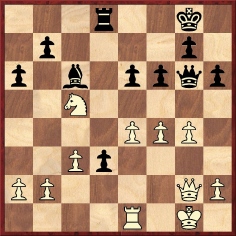
27 Rd1 f5 28 Rxd3 Rxd3 29 Nxd3 Bxe4 30 Ne5 Qf6 31 Qd2 fxg4 32 Nxg4 Qg6 33 h3 Bd5 34 Kf2 Qe4 35 Ne5 Qg2+ 36 Ke3 Qxh3+ 37 Kd4 Qh1 38 c4 Qg1+ 39 Qe3 Qxe3+ 40 Kxe3 Bc6
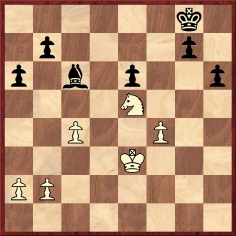
41 Kd4 h5 42 b4 h4 43 Kc5 h3 44 Ng4 Bf3 45 Nh2 Be2 46 a4 Kf7 47 b5 axb5 48 cxb5 Bd1 49 a5 Be2

50 a6 b6+ 51 Kxb6 Bd3 52 a7 Be4 53 Kc7 e5 54 fxe5 Ke6 55 b6 Kxe5 56 b7 Bxb7 57 Kxb7 Kf4 58 a8(Q) Kg3 59 Qb8+ Kg2 60 Kc6 g5 61 Kd5 Kh1 62 Ke4 g4 63 Nxg4 Resigns.
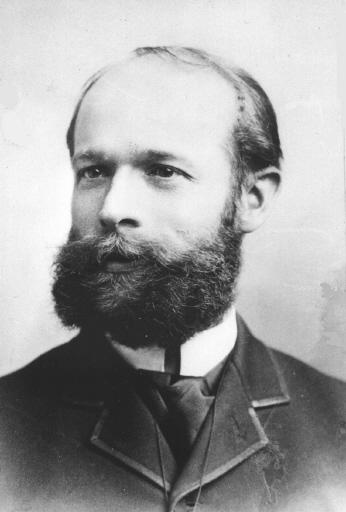
Readers should not have too much difficulty in identifying this familiar chess name, thanks to an obliging clue: the French Defence.
Avital Pilpel (Haifa, Israel) writes:
‘A chess figure who was active for an exceptionally long period was A.L. Mohiliver of Jerusalem. He published two chess problems in the Egyptian Post in 1921 and edited a chess magazine, Ha’sachmat, in Palestine in 1924. He was still active in 1992, publishing, for example, a short note on the 70th anniversary of Jerusalem’s Rubinstein Chess Club.’
Mr Pilpel provides the following sources for this information about Mohilever, whom Jeremy Gaige’s Chess Personalia lists as born in Białystok, Poland on 16 May 1904:
Sachmat, be’taon ha’igud ha’israeli le’sachamat, October 1992, page 32.
Ha’problemai Ha’israeli: Yesodot Ha’kompositzia Ha’sachmetait by Eliahu Fasher (Tel Aviv, 1964), page 35.
Ha’sachmat, Tishrey-Heshvan 5684 (September-October 1923). Mohiliver was the editor of the ‘general and games section’ (page 1), and page 26 reprinted his 1921 problems.
Below is an extremely scarce, though poor-quality, photograph of Capablanca and Alekhine in Buenos Aires, which we reproduce from page 2 of the newspaper Crítica, 18 September 1927:
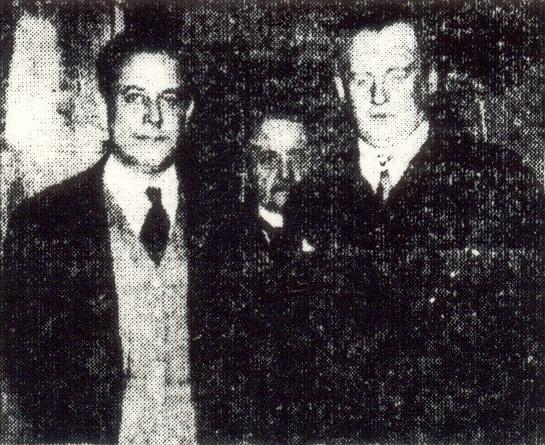
Sven Mühlenhaus (Düsseldorf, Germany) writes:
‘The claim that the game originated with Greco was also made (naturally with no source provided) by Hans Carl Opfermann on pages 25-27 of his book Die Spielgeheimnisse der großen Schachkämpfer (Düsseldorf/Vienna, 1978). In his truly hilarious but simultaneously unreadable annotations Opfermann even implied that he knew what Greco and his opponent were thinking. The depth of Opfermann’s knowledge of chess history is illustrated by the fact that he systematically referred to Howard “Stounton”.’
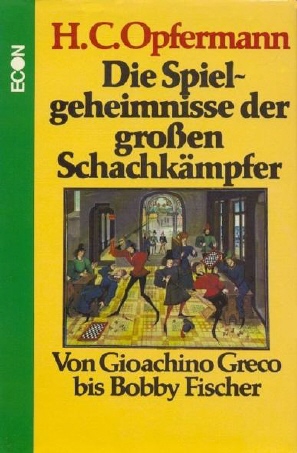
A question often asked but never authoritatively answered concerns the origins of the term ‘Fegatello’ (Fried Liver Attack) for the opening 1 e4 e5 2 Nf3 Nc6 3 Bc4 Nf6 4 Ng5 d5 5 exd5 Nxd5 6 Nxf7. It may be felt that if even the late Adriano Chicco, who had an unparalleled knowledge of Italian chess history, could not solve the mystery, nobody is likely to. Even so, it is worth trying to work back through the centuries to trace the earliest extant use of ‘Fegatello’ and its equivalents in other languages, on the basis of exact citations. Readers’ contributions will be welcomed.
As background information, below is the entry on ‘Fegatello’ on page 217 of the Dizionario enciclopedico degli scacchi by A. Chicco and G. Porreca (Milan, 1971):
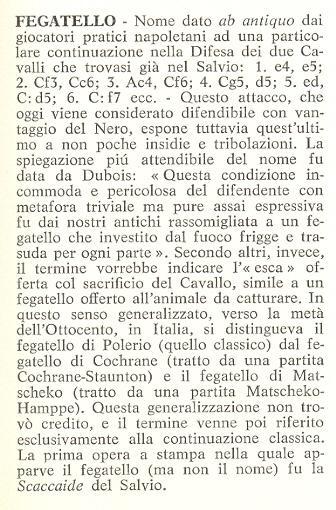
C.N. 4573 quoted the following advice:
‘Generally keep the L so that it may not be pinned by an M or an N, or be attacked when an O checks.’
It appeared on page 55 of A Complete Guide to the Game of Chess by H.F.L. Meyer (London, 1882), which we described in C.N. 2755 (see pages 59-60 of A Chess Omnibus) as ‘one of the few nineteenth-century chess books in English to use the algebraic notation’.
With leaden ingenuity Meyer explained (on pages 12-15 of his book) that the letters A to H were used for the files on the board and the letters K to P for the units:
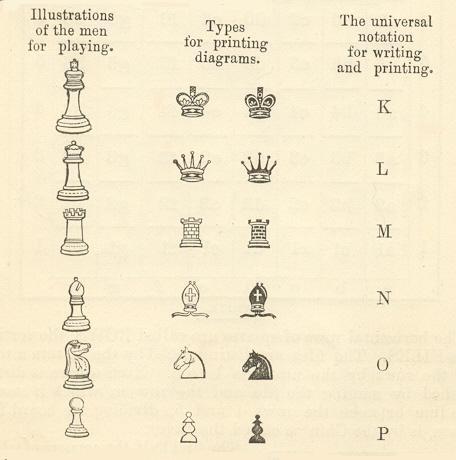
As names Meyer then offered King, Lady Queen, Monument, Neighbor, Over-leaper and Pawn or, as an unnamed American writer had proposed, Keeper, Lord, Master or Minister (also Mammoth), Nobleman, Overseer and Peasant. Meyer optimistically termed the system ‘the universal notation’.
C.N. 4580 asked which chess author also wrote medical guides and a book of poetry. The answer is Edward R. Brace, whose anthology of verse, Devils to Ourselves (Towanda, 1981), is shown below:
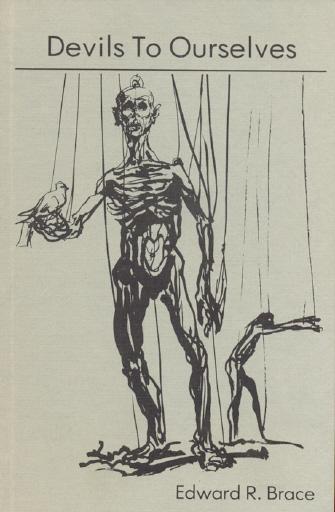
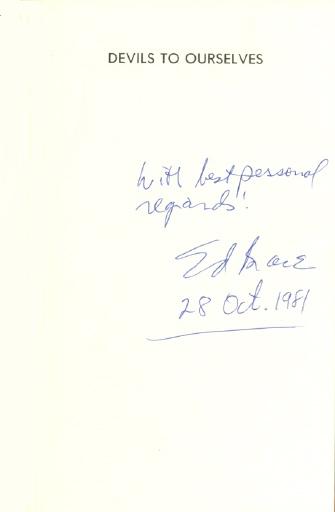
Brace was the author of An illustrated Dictionary of Chess (London, 1977), a book which, we feel, looked less good at the time of publication than it does today.
This photograph comes from page 408 of El Ajedrez en la Argentina by José Pérez Mendoza (Buenos Aires, 1920):
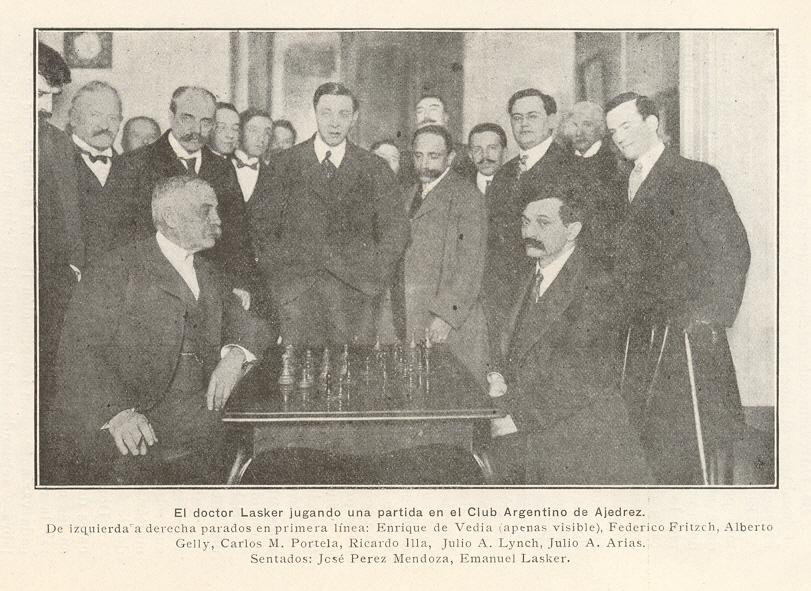
The origins of the word ‘gambit’ have often been discussed in chess literature, and on page 813 of A History of Chess (Oxford, 1913) H.J.R. Murray wrote:
‘Another result of this visit [to Rome] was that [Ruy López] learnt a slang (originally a wrestling) term of the Italian players, and was afterwards instrumental in giving the word an international currency. This is the word gambit, of which López tells us in his chess work (108 a):
“It is derived from the Italian gamba, a leg, and gambitare means to set traps, from which a gambit game means a game of traps and snares, and it is used to describe this Opening because of all the Openings which Damiano gave, this is the most brilliant and trappy.”’
See also the entries on gambetto and gomito in the Dizionario enciclopedico degli scacchi by A. Chicco and G. Porreca (Milan, 1971).
Non-authorities have given other derivations for the word gambit, such as:
When did the English word gambit first appear in a chess-related text? The Oxford English Dictionary quotes the title page of the Biochimo/Beale book The Royall Game of Chesse-Play (London, 1656), which included the words ‘Illuſtrated with almoſt an hundred Gambetts’. For a photograph of that title page, see page 32 of David DeLucia’s Chess Library. A Few Old Friends (Darien, 2003).
Surprisingly, the earliest instance of the modern English spelling of gambit cited by the Oxford English Dictionary dates from 1847 (C. Kenny). However, the first eighteenth-century book we checked (dated 1798, see below) had many instances of ‘gambit’:
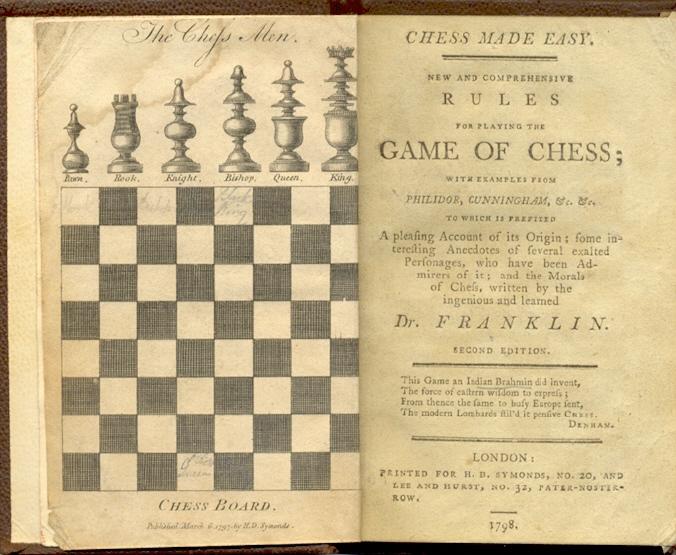
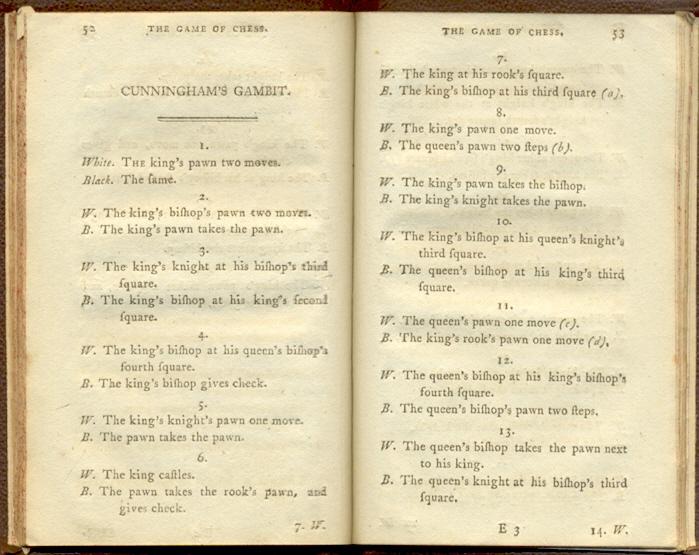
Eliot Hearst (Tucson, AZ, USA) asks if any reader can iron out a discrepancy regarding Koltanowski’s 34-board blindfold display in Edinburgh on 20 September 1937. Page 44 of George Koltanowski: Blindfold Chess Genius (Anaheim, 1990) stated that he drew on board nine against W. Geddes, whereas the game-score itself on page 52 showed Koltanowski as victorious over that player.
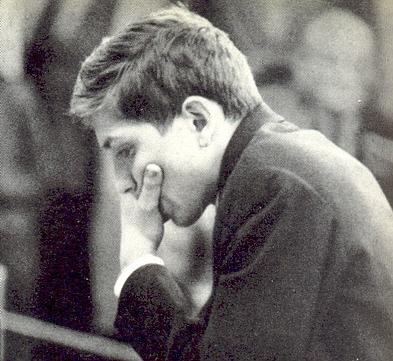
Bobby Fischer
Joop Elderhorst (Rotterdam, the Netherlands) asks about the correct game-score of Barcza v Fischer, Zurich, 1959. Whereas various books and databases state that play ended at move 95, our correspondent points out a story attributed to Tal on page 25 of Russians versus Fischer by D. Plisetsky and S. Voronkov (Moscow, 1994), as well as on pages 29-30 of the 2005 edition (published by Everyman). Below is the latter book’s translation of what Tal purportedly stated:
‘In his game with the oldest competitor, the Hungarian Grandmaster Gideon Barcza, Fischer had no advantage, but, not wishing to let his opponent go in peace, played on to the 103rd move. The game was adjourned three times and the contestants used up two score sheets, but even when there were only the kings left on the board, Fischer made two more moves!. Draw! Stunned by such a fanatical onslaught, Barcza could barely get up from his chair, but Bobby nonchalantly suggested:
“Let’s have a look at the game from the beginning. I’m sure I could have played better at some point!”
Barcza then began pleading:
“Look, I have a wife and children. Who’s going to support them in the event of my untimely death!”’
Exactly where Tal (who was a participant in the tournament; indeed, he won it) made these remarks is unclear, but we have found no contemporary source suggesting that the game continued to move 103. For example, pages 118-119 of the special issue of the Schweizerische Schachzeitung devoted to Zurich, 1959 stated that the game ended in the following position, when White had just captured his opponent’s queen with 95 Qxa4+:
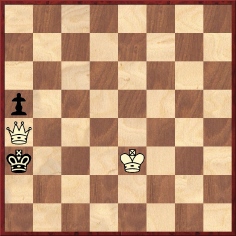
Mr Elderhorst comments:
‘It is hardly likely that another eight moves would be played in a game between masters of such a level. Moreover, for a bare-kings ending to occur Black would have had to allow White to take his pawn.’
The conclusion to Fischer’s draw against Botvinnik at the Varna Olympiad in 1962 has also given rise to discussion, on a human level. On page 153 of Analiticheskiye I Kriticheskiye Raboti 1957-1970 (Moscow, 1986) Botvinnik reported that Fischer was distraught as he left the hall. To quote the English translation on page 183 of volume three of Botvinnik’s Best Games (Olomouc, 2001):
‘Only here, with his face [as] white as a sheet, did Fischer shake my hand, and with tears in his eyes he left the hall.’
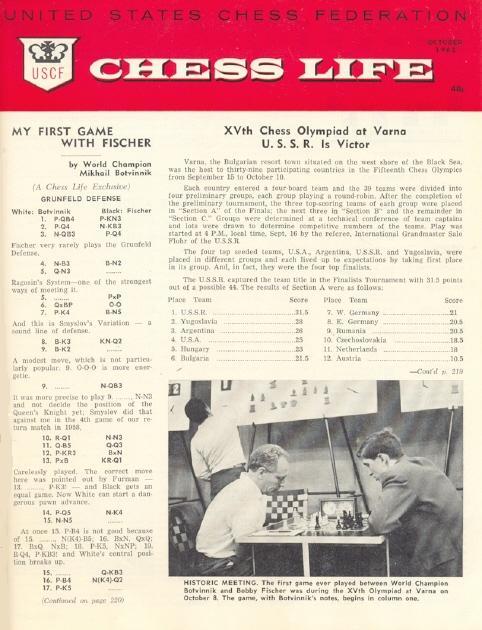
The matter arose on page 137 of the September 1963 Chess World when C.J.S. Purdy was discussing Alexander Kotov:
‘I also knew that he was a very kindly writer. I have never known him to treat anyone unkindly in print. By contrast, his countryman Flohr, a clever journalist, handled Bobby Fischer almost spitefully, when he reported that after he had only succeeded in drawing with Botvinnik in Varna, after having a winning advantage, he left the room and, having reached the corridor, burst into tears. As Fischer probably thought he was alone by then, it was cruel to record such a thing, but Flohr knew it was good “copy”. Kotov would never initiate such a story. Nor would I myself; I am prepared to use it once it has been made public already, for I am not a censor, but I think Kotov is too kind even to do that ...
I do not decry Flohr. There is virtue in sheer truth. But Flohr could have written sympathetically or purely factually, without spiteful overtones.’
Can a reader quote Flohr’s exact words?
We note webpages announcing the forthcoming publication by the Yellow Jersey Press of a book about Fischer, The Mad Master by Rene Chun. As if the title were not enough, the work is being touted as ‘the first biography’ of Fischer.
Drawing attention to a Chessbase report on a street/square in Szeged, Hungary which is named after Géza Maróczy, Calle Erlandsson (Lund, Sweden) asks whether a list of chess-related cases exists.
A number of C.N. items on pages 105-106 of Chess Explorations are of relevance, but we are aware of no comprehensive list.
Leo Mano (Rio de Janeiro, Brazil) submits an inscription by Henrique Mecking in his 1981 book Como Jesus Cristo Salvou a Minha Vida (‘How Jesus Christ Saved My Life’):
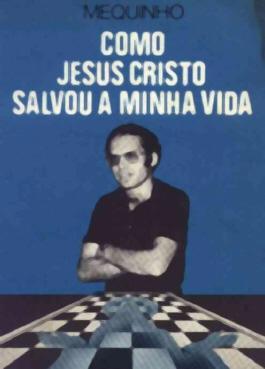
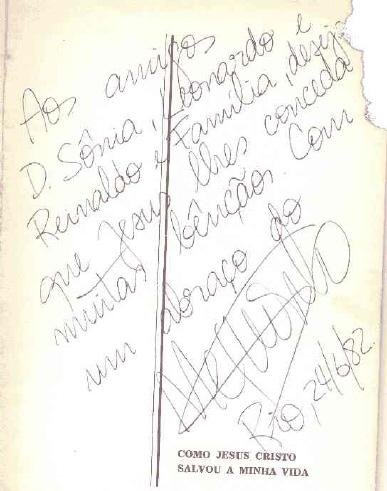
From Christian Sánchez (Rosario, Argentina) we have received the following news report on page 3 of La Nación, 17 December 1926:
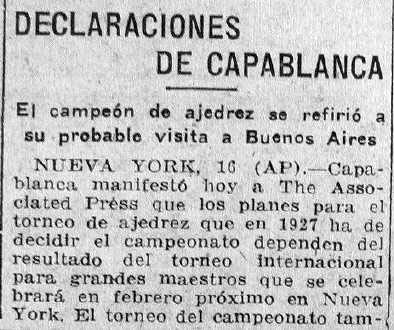

At that time it was unknown where the next world championship match would take place and who Capablanca’s opponent would be. In the report the Cuban stated that he was perfectly willing to play against Alekhine, under the London Rules, and that Alekhine now had priority since Nimzowitsch had been unable to obtain financial support for a match in Europe. Page 194 of our book on Capablanca quoted a letter dated 21 September 1926 in which he gave Nimzowitsch until 1 January 1927 ‘to show what you can do towards obtaining the necessary funds for the match’, after which we remarked that ‘the deadline of 1 January 1927 came and went without Nimzowitsch following up his challenge’. The report in La Nación shows that, already by mid-December 1926, Capablanca had been notified of the failure of Nimzowitsch’s attempt.

C.N.s 3715 and 3726 discussed, with many illustrations, the artist and chess patron Léonardus Nardus, who was of regular assistance to the careers of F.J. Marshall and D. Janowsky.
Now Peter van Hooren (Kortenhoef, the Netherlands) draws to our attention a recent book on art history which reports that Nardus was a swindler and forger. The volume in question is Van Cuyp tot Rembrandt. De verzameling Cornelis Hofstede de Groot edited by Luuk Pijl (Ghent, 2005), and the main charges against Nardus, from page 77, are given in the extract below:
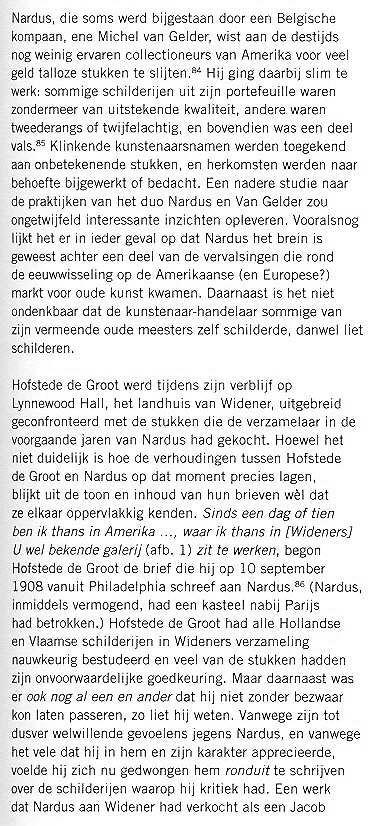
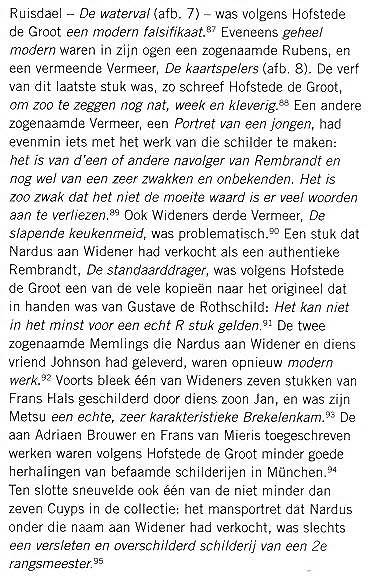
These accusations against Nardus are corroborated in the notes section (page 306). We hope to keep abreast of, and report on, art historians’ further investigations into the affair.
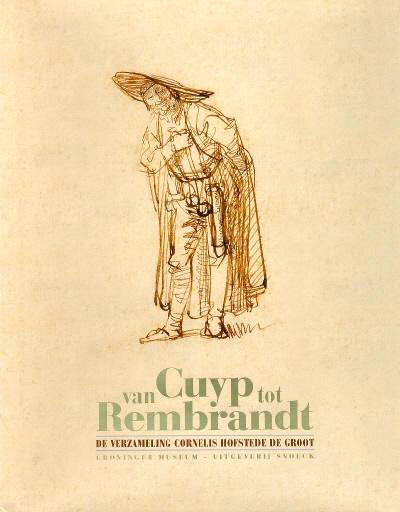
Concerning Koltanowski’s blindfold exhibition in Edinburgh on 20 September 1937, his book George Koltanowski: Blindfold Chess Genius (Anaheim, 1990) purported to give the game-scores of all 34 contests. However, comparisons with the report by Ian Hamilton, one of the controllers, on pages 43-44 of CHESS, 14 October 1937 throw up discrepancies. For example, Hamilton wrote:
‘One player, R. Ewart, was offered a draw – he refused and a little later Koltanowski cleverly won a piece and the game. Miss Gilchrist, the last to finish, should have had a draw but by a piece of cunning endgame play Koltanowski snatched the win just on midnight.’
Blindfold Chess Genius gave those two Koltanowski wins respectively as:
Why would Koltanowski have offered Ewart a draw, and where did he win a piece ‘cleverly’? And how could the latter game have been ‘the last to finish’ in a display which the above-mentioned book said lasted 14 hours (or 13½ hours, according to Hamilton’s report)?
Michael Clapham (Ipswich, England) mentions that the word ‘gambit’ appeared regularly in The History of Chess by R. Lambe (London, 1764):
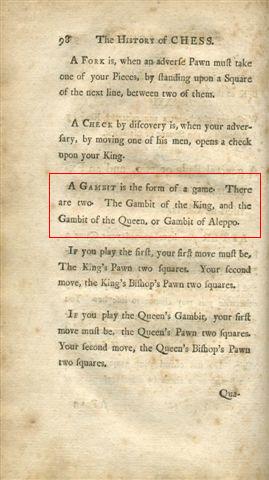
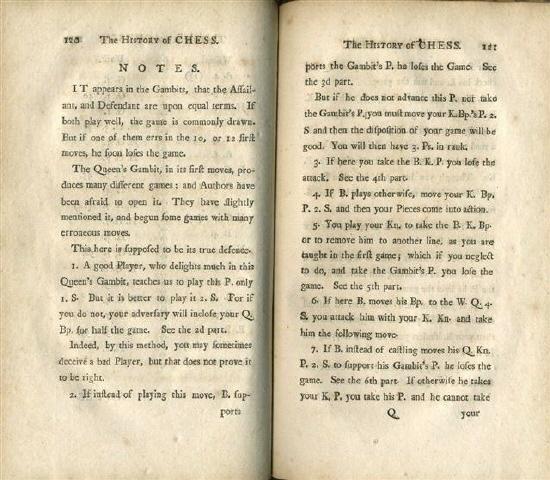
Our correspondent points out that the book is also relevant to the discussion of old works in English which adopted the algebraic notation (see C.N. 4589):
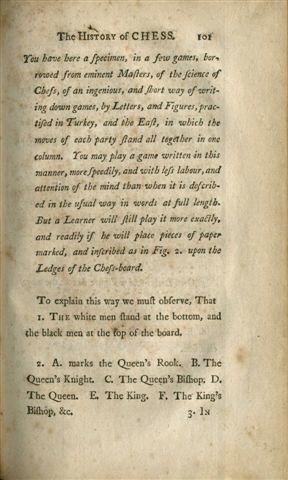
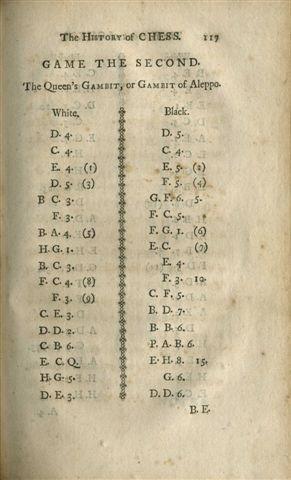
The first field to have a world champion is a question broached in C.N. 3030 (see page 269 of Chess Facts and Fables) and discussed in items on draughts/checkers (C.N.s 4413, 4418 and 4434). An interesting addition comes from page 46 of a book mentioned in C.N. 3911, What’s What by William Hartston (London, 2005):
‘In 1873, billiards became the first game or sport to hold an official world championship. It was won by a Frenchman called Gamier. The second recreation to have a world championship was chess in 1886.’
Concerning the billiards event, particulars from contemporary sources will be welcomed.
A new edition of What’s What, slightly amended, has just been published under the title Mr Hartston’s Most Excellent Encylopedia of Useless Information.
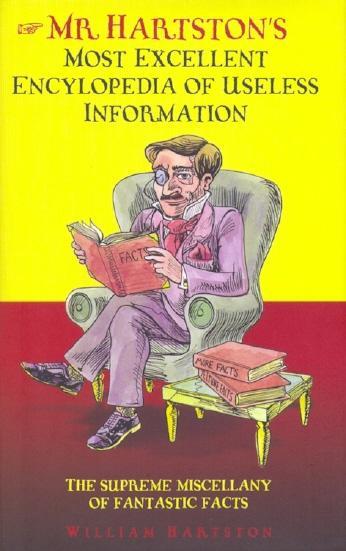
The fact that the title has the spelling ‘encylopedia’, and not encyclopedia, throughout (on the dust-jacket, the cover, the title page and the running head on odd-numbered pages) is likely to be regarded, in a Hartston volume, as an in-joke. After all, the back cover of his 2004 book What Are The Chances Of That? mentioned that his surname is often misspelt, whereas the title page appeared thus:
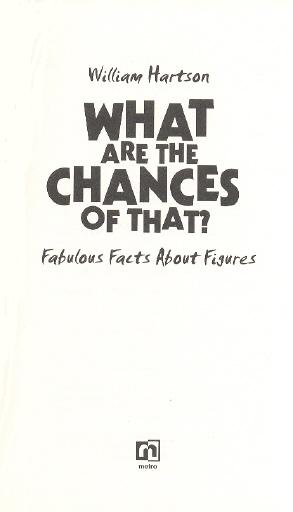
William Hartston (Cambridge, England) writes:
‘The spellings were not in-jokes. The missing “c” in encyclopedia was just a huge blunder by the publishers. Anticipating questions about it, I prepared two answers: a) it’s the American spelling; b) it’s a deliberate misprint in order to make the first edition more valuable.
The misspelling of Hartston was just as accidental, and slightly less forgiveable. I never saw the title page of What Are The Chances Of That? pre-publication, so did not have an opportunity to spot the misspelt name. They did send me a copy of the jacket of the “Encylopedia”, but I suspect that I was so relieved at seeing Hartston spelt correctly that I did not notice the blunder.
If there is another edition of What Are The Chances Of That?, I shall include in the entries for the numbers 1 and 216:
1 – number of “t”s missing from Hartston in the title page of the first edition of this book.
216 – number of times “encyclopedia” is misspelt in Mr Hartston’s Most Excellent Encylopedia (sic) of Useless Information.
On the subject of spellings, I now understand that the French billiards player I mentioned was (Albert) Garnier, not Gamier.’
Quiz question: who made the observation below?
‘Life is an insipid interruption of chess.’

This is John Lindsay McCutcheon (1857-1905), remembered more or less solely for his line in the French Defence (1 e4 e6 2 d4 d5 3 Nc3 Nf6 4 Bg5 Bb4).
From Nigel Short (Athens):
‘Unlike Winston Churchill, I never imagined that my each and every creation would be of interest to posterity. By the time that I realized that my chess games, at least, were of some interest to historians and enthusiasts, my poor archival habits were so deeply ingrained that I was unable to change. As a consequence, a number of even relatively recent games have been lost, such as from Shymkent, Kazakhstan, 1999. Therefore, alas, the short reply regarding C.N. 4572 is “No, I do not have the game-score”, although I can tell you, from memory, that it began 1 e4 e5 2 Nf3 Nc6 3 Bb5 a6 4 Ba4 Nf6 5 O-O Be7 6 Re1 b5 7 Bb3 d6 8 a4 Bd7 (8...Bg4 is more regular) 9 c3 Na5 10 Bc2 c5 11 d4. That is it, I am afraid.
Other titbits about the game:
1) It started late (rather scandalously, in my opinion) to accommodate Reshevsky’s religious beliefs. While this may be just about permissible, at the discretion of the opponent, at the start or during the middle of the event, it is an outrage in the last round, when prize-money is at stake and when the players in question, knowing other results, possess the knowledge of whether to strive for a win and risk defeat or to settle for a draw.
2) The conversation between Reshevsky and me during the game, as reported by John Nunn, is more or less completely accurate. I exerted a lot of pressure in the middlegame, which brought Reshevsky to the brink of defeat. However, he defended with great resourcefulness in time-pressure and extricated himself with ingenuity. I was very impressed that he could still play so well at such an advanced age. I was less impressed, however, with his comment “You see, you could have saved yourself a lot of time” which he made as we signed the score-sheets. It was a rather bitter remark by a man who resented having been made to sweat profusely.
My only other Reshevsky recollection, which is not connected with Lugano, is that when we met at the Kasparov v Karpov match in New York in 1990 he asked me to help him find some tournament invitations in England. I did not have the heart to tell him that England was a chess wasteland, so I said I could see what I could do. I would like to think that I will go out the same way – still hungry for the game until the last – but I probably won’t.
On a tangentially related topic: would anyone have the game-scores of the World Junior Championship from Mexico in 1981? It is undoubtedly one of the most important tournaments in my career for which ChessBase has no games (Cvitan, Salov, Ehlvest, Hjartarson, Milos, Morović and Agdestein were among the participants). Unfortunately, I cannot even remember whether any bulletins were produced.’
Richard Reich (Fitchburg, WI, USA) writes:
‘A fantasy series by George R.R. Martin (four volumes so far) is popular. The latest volume, A Feast for Crows, refers to a noble family named Staunton and has a character named Alekyne. Martin was once a tournament director for Bill Goichberg’s Continental Chess Association in the United States.’
Most volumes in the British Year-Book series, which covered the period 1907 to 1916, were edited by E.A. Michell. He published or co-published other chess books too, but little is currently known about him. His 1912 Year-Book featured, on pages 301-316, the ‘Chess Lovers’ Kalendar compiled by Miss Clara Millar’, a list of birth- and death-dates which included the bare information that E.A. Michell was born on 11 September 1879.
The unpublished 1994 edition of Jeremy Gaige’s Chess Personalia noted that in 1908 Michell (forenames: Edward Algernon) obtained a Bachelor of Arts degree from The Queen’s College, Oxford. What more can be discovered about him?
From Bruce Monson (Colorado Springs, CO, USA):
‘I am trying to locate information about Herman Steiner’s childhood and family history in Hungary, along with other information following his arrival in New York in the 1920s. Almost nothing is known about this phase of his life.’
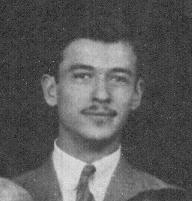
Herman Steiner
In 1959 whom did Harry Golombek call ‘perhaps the greatest chessplayer that ever lived’?
To the various photographs of L. Nardus already given in C.N. is added the following, from page 43 of The Gambit, February 1930:
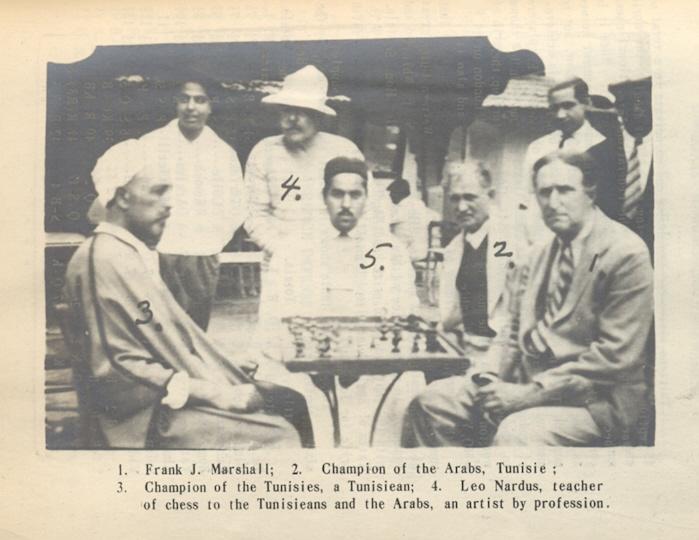
From Michael McDowell (Westcliff-on-sea, England):
‘In G.F. Anderson’s book A Memorial Volume of Chess Problems of V.L. Eaton (page 2) the second problem is the following:
V.L. Eaton, 10th Honourable Mention, Cincinnati Enquirer, 3 November 1929
Mate in two.
Key: 1 Bb7.
Anderson’s commentary reads:
“Several solvers were lyrical about No. 2. One wrote: ‘If the author is really “just a boy” and “just a novice”, as you mention in your comment, it is really remarkable because I can picture the existence of a prodigy in music, in painting, or in any department of Art, even in practical chess playing, but I cannot bring myself to believe there can be any such thing as a prodigy in chess problem constructing.”
To which Anderson added:
“He was wrong of course, because chess problem composition is a ‘department of Art’.”
Eaton was born on 31 August 1915. Problem 1 in Anderson’s collection was published in the Cincinnati Enquirer on 22 September 1929 but is poor compared to the above problem. The book also mentions that an earlier problem was published in the Washington Post some time in 1929, but was cooked.
Fourteen does not seem particularly young to be starting composition, especially when Lilian Baird is considered. A more striking case is the following:
R. Rastogi, The Problemist, May 1979
Mate in two.
Key: 1 Be7.
Barry Barnes’ commentary read:
“C6216 is a first problem by Master Rastogi, who is a ten-year old Indian lad at Robert McWilliam’s school. Old readers will recall the McWilliam Tourneys, which did so much to foster young ‘under 21’ talent.”
Alas, Master Rastogi appears not to have composed a second problem.
On the subject of prodigies, I would also draw attention to page 89 of Sam Loyd and his Chess Problems by A.C. White, which discusses the Bettmanns and the mysterious Harry Rowe. (I have never seen a problem by the latter.)’
Regarding V.L. Eaton, who died in 1962, below from our collection is an undated index card addressed by him to an unidentified correspondent:
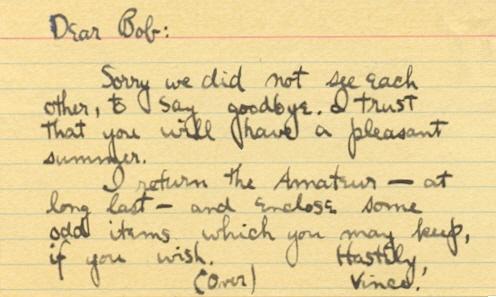

A relatively easy question: in which tournament did all the following participate?
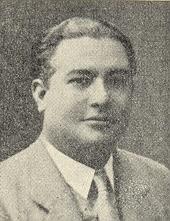
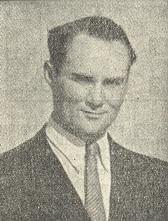
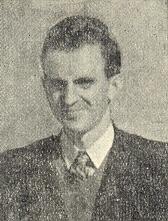
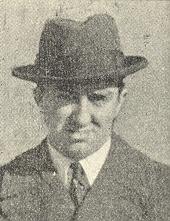
Brian Karen (Levittown, NY, USA) quotes a remark by Veselin Topalov on pages 29-30 of the 5/2005 New in Chess:
‘I am not really afraid to lose. ... This makes the difference between me and the others. In my opinion they take defeats worse than I do.’
Our correspondent asks for other quotes by leading players, past and present, on their attitude to losing. As ever, only little-known observations are sought, and exact sources are naturally required.
Concerning Topalov our collection contains a single book:
As regards books by and about Kramnik’s career we have the following:
Information about additions will be welcomed.
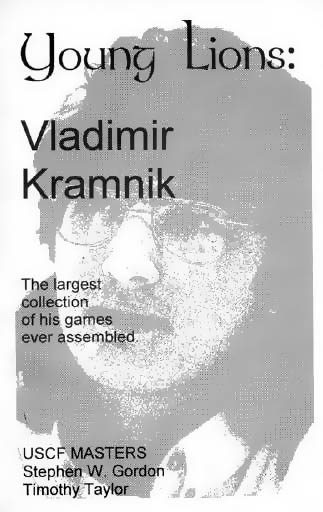
Alan McGowan (Waterloo, Canada) draws attention to an article he has written on Koltanowski’s Edinburgh display at the Chess Scotland website.
Ian Matthew (Portsmouth, England) points out that a number of Nigel Short’s games in the 1981 World Junior Championship were included in the FatBase database. It has yet to be ascertained whether any bulletins on the event were issued.
At a press conference in Belgrade on 26 October 1992 Boris Spassky stated that Tigran Petrosian had been ‘the richest man in the Soviet Union’.
Source: page 230 of No Regrets by Y. Seirawan and G. Stefanović (Seattle, 1992).
Can Spassky’s assertion be corroborated?
It was Paul Morphy whom Golombek described as ‘perhaps the greatest chessplayer that ever lived’.
Source: page 51 of his book Modern Opening Chess Strategy (London, 1959).
From Michael Syngros (Amarousion, Greece) comes news of another book on Topalov:
Jim Kulbacki (Cheyenne, WY, USA) sends an advertisement featuring Frank J. Marshall, from the Saturday Evening Post, 28 April 1934:
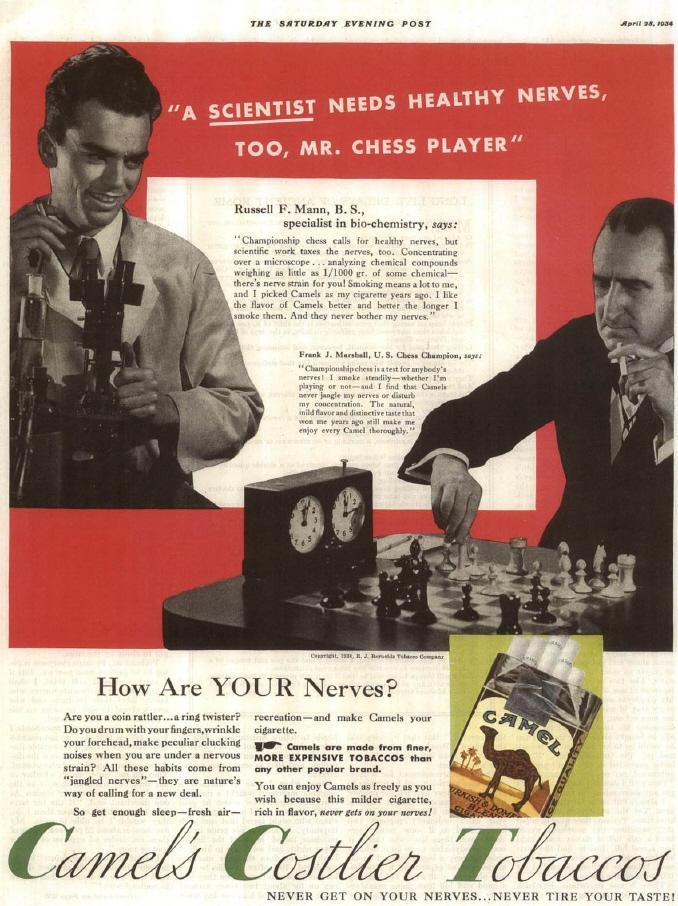
As regards chess prodigies, Tomasz Lissowski (Warsaw) submits the following from the 23 January 1903 issue of the Cracow publication Ilustracja Polska, whose chess editor was Aleksander Wagner:
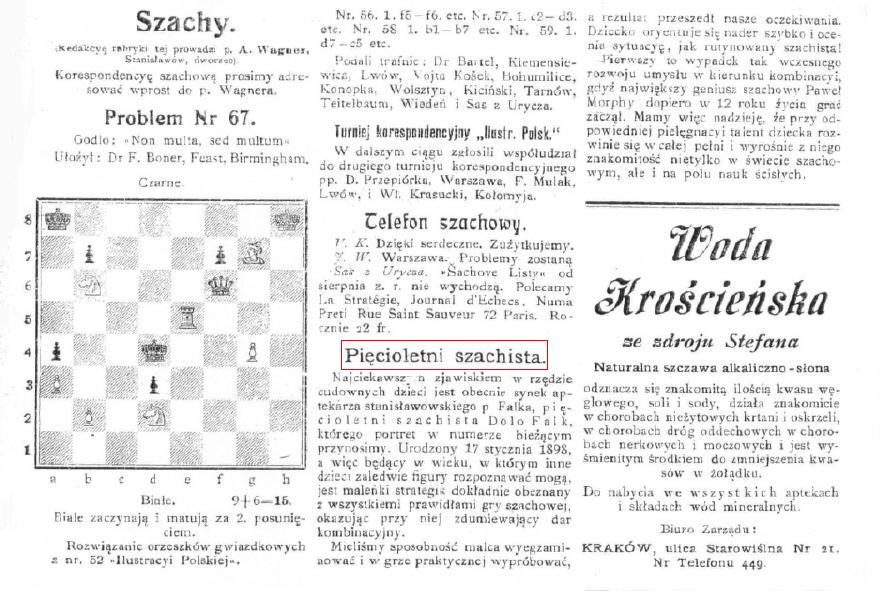

Our correspondent has provided a translation of the text. The only concrete facts are that Dolo Falk was the son of a pharmacist in Stanisławów and was born on 17 January 1898. Mr Lissowski comments that no game-scores by Falk are known.
The prodigy was mentioned in a footnote on page 80 of A Chess Omnibus, and we now see an error there: the issue of the Belgian magazine Revue d’échecs in which the report on Falk appeared was May 1903. The full text is given here:

The above is the entirety of our current knowledge about Dolo Falk.
Yakov Zusmanovich (Pleasanton, CA, USA) adds to the list of Kramnik books:
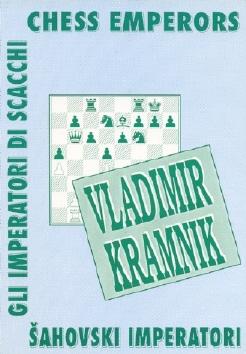 One of the
volumes mentioned in C.N. 4616, Vladimir Kramnik
(Szolnok, circa 1995), had (on pages 5-6) a brief
biography in ‘English’. Some highlights are reproduced below:
One of the
volumes mentioned in C.N. 4616, Vladimir Kramnik
(Szolnok, circa 1995), had (on pages 5-6) a brief
biography in ‘English’. Some highlights are reproduced below:
‘Kramnik is the youngest one in the pleiad of today’s top-level world Grandmasters of today. ... His baptism of fire in the cycle for the world Championship was in July in 1993 in Bill. At the very beginning he burned himself at the Dutchman Van Vely, but later on he walked through the Swiss chess temple in triumph.
The eight-part finals match against Leonid Judasin was only a playing-in for Volodja (Kramnik is called so by his Russian fellows) ...
Volodja will surely remember the New York June in 1994 for a long time. He encountered the pitiless attacker, Gata Kamsky. ... The Russian longlegged suffered the great defeat but he didn’t waver. He maintains the high reputation and eats chess bread pleasantly at tournaments all over the world ...
Kramnik, however, differs very much from his somewhat older fellows of same age, who almost began to rule over the chess world. He is a nonconformist out of the chess board. He does not avoid the night associations, he is a passionate smoker and drinks willingly a small cup more as well.
... Volodja does not like to play dice at the chess board. He does it only as an unnecessary factor in the chess bag. He hand to do it once in his life. As a boy he used to play the table tenis excellently, he used to enjoy in goals on the green ground carpet. It is said that he was predicted some people the career of a top-ranking football goalgeter. The empire of the white-black squares, however, was more provocative one.’
| First column | << previous | Archives [26] | next >> | Current column |
Copyright 2006 Edward Winter. All rights reserved.